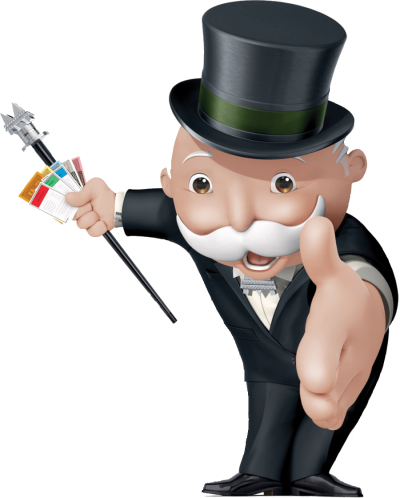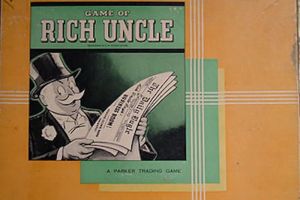Mr. Monopoly
| Mr. Monopoly | |
|---|---|
| Vital statistics | |
| Names | Mr. Monopoly, Monopoly Man, "Rich Uncle" Pennybags, Milburn Pennybags, Monopoly Guy |
| Gender | Male |
| Race | Human |
| Occupation | Banker |
| Origin | Monopoly (Community and Chance Cards) (1936) |
| Alignment | Neutral |
| Age | Over 60 |
| Created By | Philip Orbanes, Parker Brothers |
| Height | Not Stated |
| Weight | Not Stated |
| Personality Type | {{{personality type}}} |
Mr. Monopoly is the mascot for the board game Monopoly. He is portrayed as a chubby elderly man with a mustache, dressed in a morning suit with a bowtie and a top hat. Around the world, he is also known as the Monopoly Man, "Rich Uncle" Pennybags, Milburn Pennybags, or the Monopoly Guy. He appears in various related games, including Rich Uncle, Advance to Boardwalk, Free Parking, Don't Go to Jail, Monopoly City, Monopoly Junior, and Monopoly Deal.
The character first appeared on Chance and Community Chest cards in the U.S. editions of Monopoly in 1936. The designer of the character, artist Daniel Fox, was not identified until 2013, when a former Parker Brothers executive, Philip Orbanes, was contacted by one of Fox's grandchildren.[1]
Appearance
Mr. Monopoly is a rotund elderly man characterized by:
- White Mustache: A prominent feature that adds to his distinguished appearance.
- Top Hat: A classic accessory, adding to his formal look.
- Morning Suit/Tuxedo: He wears a black tuxedo or morning suit, reflecting his wealthy status.
- Silver Monopoly Dollar Sign [M̶] Collar: Replacing his original red or black bow tie, this detail emphasizes his connection to the Monopoly game.
- Black I-Shaped Cane: Featuring a silver Monopoly Dollar sign [M̶] on a top-hat-shaped tip, which can also function as a wand. The cane originally had a brown J-shaped design.
Mr. Monopoly's appearance is thought to have been inspired by Otto Khan, a German-born American investment banker.
Personality
Mr. Monopoly is portrayed as:
- Extremely Wealthy: He embodies the character of immense affluence.
- Fun and Joyful: Despite his wealth, he maintains a cheerful and entertaining demeanor.
- Interactive in Games: In the 2008 Wii game "Monopoly," he announces various game events, such as forming a monopoly, landing on Chance/Community Chest, and other game actions, showcasing his lively personality.
History
- Early Appearance and Naming: The character, later known as Rich Uncle Pennybags, made his first appearance outside Monopoly in the Parker Brothers' game Dig, released in 1940.[2] He was officially named in 1946 when Parker Brothers produced the game Rich Uncle, where his likeness appeared on the box lid, instructions, and currency. Rich Uncle Pennybags is believed to be modeled after J.P. Morgan, a prominent American businessman from the Progressive Era.[3]
- Monopoly Game Logo: From 1985 to 2008, the character appeared in the second "O" in the word "Monopoly" as part of the game's logo. More recently, he is depicted over the word "Monopoly" in a 3-D style, extending his right hand, although he no longer appears on every game box uniformly.[4][5]
- Character Naming in Books: In 1988, Philip Orbanes published The Monopoly Companion, where all the Monopoly board characters were named. Rich Uncle Pennybags' full name was given as Milburn Pennybags, while the character "In Jail" was named "Jake, the Jailbird," and the police officer on "Go to Jail" was named "Officer Mallory."
- Renaming to Mr. Monopoly: In 1999, Rich Uncle Pennybags was renamed "Mr. Monopoly." The same year, a Monopoly Jr. CD-ROM game introduced his niece and nephew, Sandy and Andy. The books Monopoly: The World's Most Famous Game & How It Got That Way and The Monopoly Companion mention a second nephew named Randy and state that Mr. Monopoly has a wife named Madge.[6]
- Forbes Fictional 15: Mr. Monopoly was listed as the sixth richest fictional character in the 2006 Forbes Fictional 15 and the ninth richest in 2011.[7]
Legacy
- Political Activism: In 2017, a staff member of the activist group Public Citizen, dressed as Mr. Monopoly with an added monocle, gained media attention by photobombing the CEO of Equifax during a US Senate hearing. The stunt aimed to highlight the use of "forced arbitration" that limited consumers' rights to sue financial companies.[8]
- Appearances at Hearings: In 2018, during a testimony by Google's CEO Sundar Pichai before Congress, someone dressed as Mr. Monopoly was present in the audience. Again, on September 12, 2023, Ian Madrigal, dressed as Mr. Monopoly, attended Google's antitrust trial, United States v. Google LLC.[9]
- Pop Culture References: Rich Uncle Pennybags makes a cameo in Clue: Candlestick, a comic book based on the board game Clue, where he is referred to as "Milburn." [10]The Fallout video game series' mascot, Vault Boy, is partly based on Rich Uncle Pennybags.[11]
- Mandela Effect: A common false memory, known as the Mandela effect, suggests that Mr. Monopoly wore a monocle, though he never did until after this false memory became widely believed.
In licensed media, primarily including advertisements and video games, Mr. Monopoly has been voiced by several voice actors including Tony Waldman, Tony Pope, Wendell Johnson, Dean Hagopian, Mark Dodson, Larry Moran, Michael Cornacchia, Harry Aspinwall, and Rowell Gormon.[12]
Theme
References
- ↑ https://archives.museumofplay.org/repositories/3/archival_objects/10524
- ↑ http://www.toonopedia.com/pennybag.htm
- ↑ https://web.archive.org/web/20100502234420/http://bookofodds.com/Daily-Life-Activities/Hobbies-Recreation/Articles/A0725-Interview-Phil-Orbanes-Monopoly-Expert-Part-Two
- ↑ Hasbro Toy Shop page for Monopoly. The mascot character appears only on the Standard Edition set.
- ↑ USAopoly https://web.archive.org/web/20130524212754/http://www.usaopoly.com/games?terms=1
- ↑ url=https://archive.org/details/monopolycompanio00orba_0
- ↑ https://www.forbes.com/2006/11/20/uncle-pennybags-money-tech-media_cx_de_06fict15_monopoly.html
- ↑ https://www.npr.org/2017/10/06/555979792/how-monopoly-man-won-the-internet
- ↑ https://www.cnbc.com/2018/12/11/monopoly-man-returns-to-congress-for-google-ceo-pichais-hearing.html
- ↑ https://www.adventuresinpoortaste.com/2020/01/28/clue-candlestick-review
- ↑ http://www.duckandcover.cx/content.php?id=7
- ↑ https://www.behindthevoiceactors.com/characters/Monopoly/Mr-Monopoly


